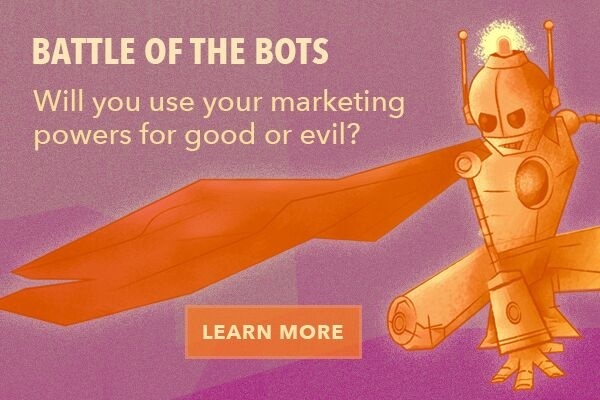AI is all the rage on tech websites, but it can still seem like a pretty obscure, inaccessible tactic for B2B companies.

The hype and expectations of AI are astronomical, yet the actual business impact it can have on B2B companies at this moment is still relatively uncertain. However, one thing I can assure you is that AI technology is advancing faster than most of us will ever be able to keep up with.
Preparing a foundation for AI now will end up paying dividends down the road.
Here, I’ll focus on two things that will play a critical role in obtaining a competitive edge with AI both now and in the future: simplifying your internal tech landscape, and advancing your team’s ability to handle more cognitive work that will arise through AI augmenting growth.
Learn more about emerging technologies: A Practical Approach to Emerging Tech for SMBs: AI, Blockchain, Cryptocurrencies, IoT, and AR/VR
Before you go ahead and jump into laying out an AI roadmap, it’s important to first consider your overall business strategy. Setting out an AI roadmap without first truly understanding where you want to go or what you’re trying to do will lead to many more complications down the road.
Establish an overarching strategy.
Strategy means different things to different people, and laying out a solid plan that everyone can work off will be an important first step. When trying to come up with a plan to capture and/or create market value, you’ll get many different perspectives and a lot of disagreement. Coming up with a broad strategy that each key department can agree on will start building a strong foundation to launch off of.
When it comes to finding areas where AI can have a large impact, ask yourself the following questions:
- What are your vulnerabilities?
- How would other startups disrupt you?
- What areas would they specifically target?
Try this exercise: assemble a team to envision how your company could potentially fail in five years. Think about the worst case scenario, and imagine what would have protected you from getting to that dire point. This can be an effective way of building a solid strategy that will open up room for innovation driven by AI and new integration AI tools like Edge AI.
Next, look at your internal processes and key interdependencies from both a technological and interdepartmental standpoint. This is where most organizations tend to get over complicated. The key here is to strive for simplicity. This will be important when it comes to quickly adopting cutting edge technology in a way that will give you a competitive edge over other companies.
What does simplicity look like? Try for something that every department can understand, not just IT. AI will play a role in every area of the organization, so having processes and a technology landscape that people can grasp will make it easier for AI adoption when the time comes.
Train your entire org on the basics of this interconnected infrastructure, and then offer opportunities for theoretical innovation from each department. Ask for ideas, solution providers, ways to simplify tasks, ideas for removing inefficiencies and increasing productivity. Have a reoccurring feedback loop where you can gather up-to-date information on what your departments feel will help them exceed. People will be much more forthcoming when they have a good understanding of how the organization operates and what could be needed/impactful.
Building out a tech landscape that everyone can understand at a basic level will be difficult, but this is critical to opening up opportunity for innovation in every part of the org. When evaluating software and platforms, think hard on how these technologies align your departments (or further divide). For example, getting several departments on one platform will allow for much easier AI adoption in the future.
While most AI tech coming out right now will be very specific to the department, there will certainly be more aggregated platform plays in the future. Adopting AI onto one of your existing platforms (that covers three to four departments) and works by one set of internal rules will be much easier than trying to layer AI onto individual departmental platforms that are siloed throughout the org and all have different sets of rules. Think about it from a language perspective — getting four countries with different languages to unite will be much more difficult than four countries with the same language.
Technology and process universalization throughout the org will go a long way when it comes to not only adopting next-gen AI technology, but training your people on how to effectively use it.
These changes will also help streamline more effective communication and allocation — an area AI will play a massive role in. Examples of AI augmenting human capabilities could look like the following:
- an employee engaging an internal bot to find critical information to their job
- a sales person rapidly creating custom/personalized content for a specific prospect assisted by AI
- a content strategist figuring out exactly what topics will drive the most traffic from AI tech
- a new hire being guided through a custom onboarding program assisted by AI
Allocation of internal resources and information will most likely be one of the biggest pieces of low hanging fruit you can seize with current AI technology. Many companies have the expectation that AI will enable their workforce through increased productivity and allocation of information and resources. This is where I want to shift away from tech simplification and look towards what will most likely be the most important aspect of AI adoption: training your people.
Your team is the key to capturing growth via AI.
Creating an overarching strategy that effectively ties in all departments with a simplified tech infrastructure is a great start. Having everyone from each department understand those interdependencies while embedding a constant loop of communication will allow for more ideas on innovation (many of which will be driven by AI). The next step is preparing your team so that they’re not just ready to come up with theoretical innovations — they’re ready to drive them.
If you thought things were going to get a bit easier with AI coming in to handle all of our menial tasks, I’m afraid you’re vastly mistaken. Sure, the fluff of our daily jobs will likely start to fade away. Tasks that once used minimal brain power will soon fall under your AI counterparts, as they’re the easiest to process. However, with that, the demand for humans to consistently perform higher cognitive tasks will vastly increase. Try creating a more interconnected culture where people are working on all sorts of different challenges, even outside of the department they work for.
Here’s a few ideas you could try with your team:
- Regularly meet to discuss organizational challenges you face as a leader.
- Ask for feedback on how other areas of the organization could run more effectively.
- Create micro-leadership opportunities for people on your team to do things that normally wouldn’t fall under their job scope
- Promote more content consumption and create opportunities to apply what they’re learning via special projects
- Push your team to regularly network with other departments and promote career opportunities throughout the overall organization
It’s up to you to properly enable your team for this dramatic shift where the business value of emotional intelligence will skyrocket. By adopting both a culture and organizational framework that allow individuals to initiate innovation and change, you’re taking the first step in making this happen.







![What's Holding AI Adoption Back in Marketing? [New Data]](https://blog.hubspot.com/hubfs/Featured%20Image%20Template%20Backgrounds_AC%20Copy-4.png)
![10 Challenges Marketers Face When Implementing AI in 2023 [New Data + Tips]](https://blog.hubspot.com/hubfs/ai%20challenges.png)
![How AI Can Improve Your Customer Experience [New Data + Tips]](https://blog.hubspot.com/hubfs/ai%20customer%20experience.png)
![The Complete Guide to AI Transparency [6 Best Practices]](https://blog.hubspot.com/hubfs/ai-transparency.webp)